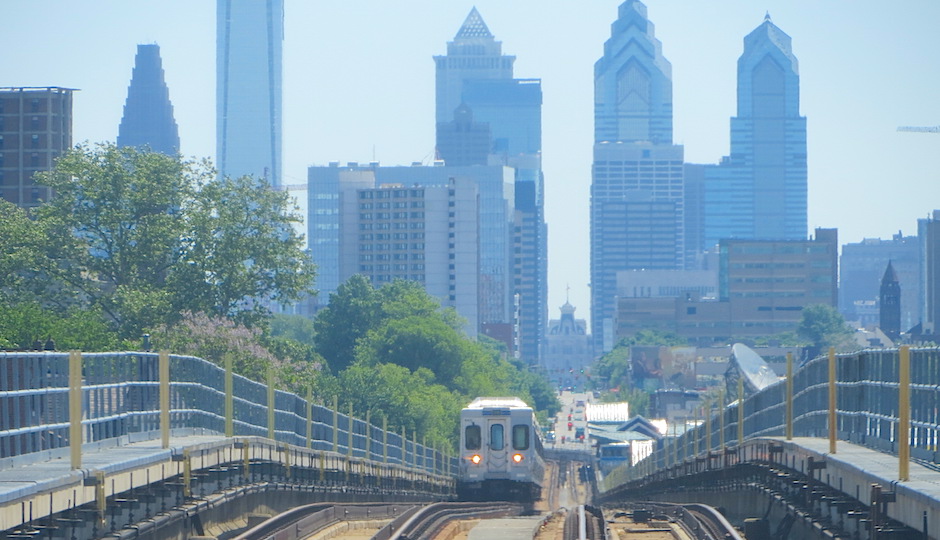How to Make the El Less Crowded

Photo credit: David Wilson via Flickr
During rush hour on the Market-Frankford Line, the air is so thick and opaque.
Jockeying for centimeters of space and sandwiched between messenger bags and puffy coats, riders on the El constantly feel squeezed. The crunch rivals the worst of a Midtown Manhattan subway. And it’s bound to get even more jam-packed: The El gained 15,000 daily riders since 2000 and, as residential developments continue to crop up along the line, those numbers are trending upwards.
Increasing capacity is a vexing problem, and one potential solution — buying new, longer subway cars — is out of the question right now. For one, the capital cost would be astronomical. When the current fleet of 220 cars was purchased in 1997, they collectively cost more than $400 million in 2016 dollars. Secondly, the length of the subway platforms at many stops can’t support longer trains, even if the money was there to purchase them. Lastly, running additional trains at peak hours — when one train arrives every four minutes as of now — is a dubious idea, given it would likely result in slower speeds and a higher inefficiency of service.
So SEPTA is left with just one choice, really, at least for the time being: It must readjust the seating on the El to generate more room.
Unbeknownst to many riders, SEPTA has already begun working on this fix. In early 2015, the transit agency began a pilot project to study whether removing two seats on six train cars would grow capacity and decrease the dwell times associated with passenger pileup. “The normal habits, especially during rush hour, are that people get on, and if they’re only going a couple stops, they’re going to hang around the doors,” says Ron Hopkins, Assistant General Manager of Operations. And that scrum of people forcing their way out of and onto the trains causes delays.
As expected, the pilot has demonstrated minimally positive effects during crunch times: Shifting some people away from the doors by replacing two seated passengers with three to four standees (or a passenger with a bulky object, like a stroller or wheelchair). The pilot was also cheap. Removing 12 seats and adding handrails cost less than $10,000 for both materials and labor. Replicating that across the entire fleet — which is something SEPTA is considering doing — would cost around $350,000.

Car displaying the piloted seat removal on the El. | Photo courtesy of SEPTA
But even if that tweak was applied to every car on the El, it would merely be a Band-Aid to heal a growing wound. Decreasing the amount of seats from 49 to 47 — and consequently growing the overall capacity from 150 to, say, 154 — will hardly make up for the anticipated growth in riders over the coming years.
What SEPTA really needs to do is rejigger the two-by-two, frontward-facing rows of seats on the El, because the design is actually a horrible use of space. According to a manual by the National Academies of Sciences, Engineering and Medicine, the El’s design (known as “transverse seating” in transit-speak) takes up approximately 20 percent more space than the aisle-facing, bench-style seating orientation that’s a fixture on many New York subways. The latter, known as “longitudinal seating,” leaves plenty more room for standing passengers and tends to allow for easier movement to and from the doors. An observational study by the New York City Transit Authority went as far as to say that “2+2 or 2+1 transverse seating should be avoided in urban environments because aisle seats may create blocking problems for both window seats and standees wishing to utilize the space.”
Not looking good, El.
A decade ago, the Chicago Transit Authority, facing capacity issues of its own, decided to make the leap to a more spacious, New York-style seating orientation. The CTA put out a $1.14-billion contract with Bombadier for more than 700 new subway cars that featured 90 percent aisle-facing seating. To put it simply, riders rebelled, as the Chicago Tribune documented:
The most common complaints from riders about the center-facing seats are that seated passengers are crammed shoulder to shoulder and thigh to thigh while also being eye-level to the crotches and buttocks of standing passengers; that in crowded conditions, standing passengers tend to accidentally step on the feet of those seated; and that views out the windows are blocked by bodies.
When the time came for the next subway-car contract, the CTA pulled back on its revolution in response to customer complaints and ordered a hybrid design, featuring both transverse and longitudinal seats, similar to what exists on the Broad Street Line. According to a spokesman for the CTA, the hybrid produced “roughly the capacity” as aisle-facing seats, without as much angst from riders.
The time is approaching for SEPTA to make a more formative adjustment to the El than removing a seat here or there — can you imagine another 15,000 daily riders in the coming decade? — and the CTA’s initial misstep should serve as a lesson.
Adjusting some but not all of the seats would increase capacity significantly, while minimizing the cost and avoiding a degree of mental disorientation for customers. When asked last November about a holistic rearrangement of seating, SEPTA General Manager Jeff Kneuppel had this to say: “It’s definitely something that we would do as an interim step to buy us more time to look at how to deal with the bigger issue. You can get scared by something like that or say, isn’t it exciting that the city is generating that kind of ridership?”